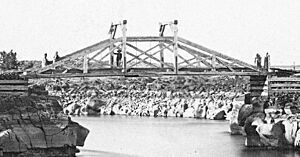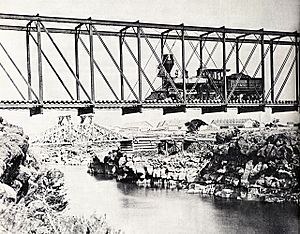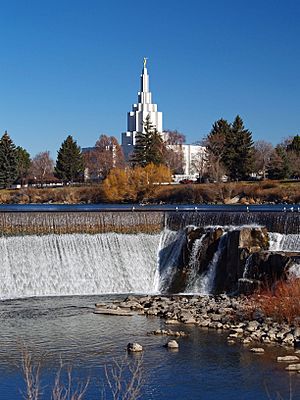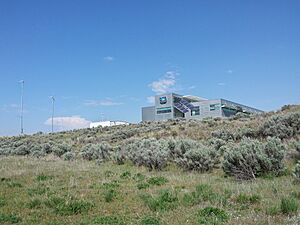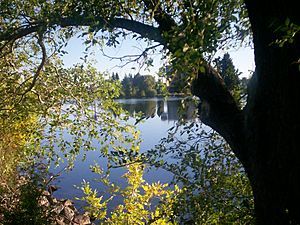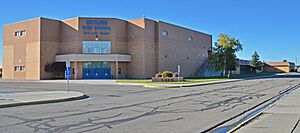Idaho Falls, Idaho facts for kids
Quick facts for kids
Idaho Falls, Idaho
|
||
|---|---|---|
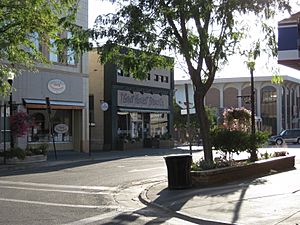
Downtown Idaho Falls
|
||
|
||
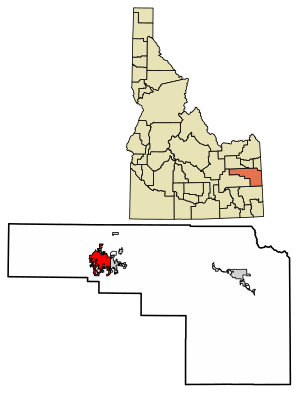
Location within Bonneville County
|
||
| Country | United States | |
| State | Idaho | |
| County | Bonneville | |
| Founded | 1864 | |
| Incorporated | 1891 | |
| Area | ||
| • Total | 24.55 sq mi (63.59 km2) | |
| • Land | 24.00 sq mi (62.16 km2) | |
| • Water | 0.56 sq mi (1.44 km2) | |
| Elevation | 4,712 ft (1,436 m) | |
| Population
(2020)
|
||
| • Total | 64,818 | |
| • Density | 2,700.75/sq mi (1,011.75/km2) | |
| • CSA | 243,805 (US: 124th) | |
| Time zone | UTC−7 (Mountain) | |
| • Summer (DST) | UTC−6 (Mountain) | |
| ZIP Codes |
83401–83406, 83415
|
|
| Area code(s) | 208, 986 | |
| FIPS code | 16-39700 | |
| GNIS feature ID | 2410091 | |
| Interstate | ||
| U.S. Highway(s) | ||
| State Highway | ||
Idaho Falls is a large city in Idaho. It is the fourth most populated city in the state. Idaho Falls is also the main city of Bonneville County. In 2020, about 64,818 people lived there.
Idaho Falls is a busy place for business, culture, and healthcare in Eastern Idaho. It also serves parts of Wyoming and Montana. The city has its own airport, the Idaho Falls Regional Airport. You can find the College of Eastern Idaho, the Museum of Idaho, and the Idaho Falls Idaho Temple here. It's also home to the Idaho Falls Chukars minor league baseball team.
Contents
History of Idaho Falls
How Idaho Falls Began
Idaho Falls started as a place called Taylor’s Crossing in 1864. It was named after a man named Matt Taylor. He built a wooden bridge across the Snake River in 1865. This bridge helped people travel west on the Montana Trail. It was safer than the ferry that was used before.
The bridge made it easier for settlers, miners, and traders to reach places like Bannack and Virginia City. These towns in Montana were famous for their gold.
From Eagle Rock to Idaho Falls
By 1866, the town was known as Eagle Rock. This name came from a small island in the Snake River. Many eagles used to nest there. Before the bridge, a ferry also operated at this spot. So, the area was already known as Eagle Rock. The town grew with a bank, a hotel, and a place for horses.
In 1879, the Utah and Northern Railway (U&NR) came to Eagle Rock. The railroad built a new iron bridge across the Snake River. This bridge was 800 feet (244 meters) long! The railroad helped the town grow even more. Many settlers came to the Upper Snake River Valley. They started farms and built irrigation canals. These canals brought water from the Snake River to turn dry land into green farms.
In 1891, the town changed its name to Idaho Falls. This new name came from the fast-moving water, or rapids, below the bridge. Later, a power plant was built, which made the rapids look more like waterfalls. By 1895, a huge irrigation canal, called the Great Feeder, helped turn thousands of acres into farmland. The area became known for growing crops like sugar beets, potatoes, and grains.
Nuclear Research and Innovation
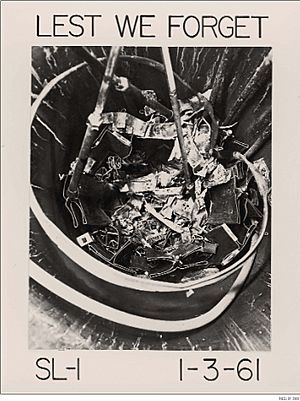
In 1949, the Atomic Energy Commission opened a special research center. It was called the National Reactor Testing Station. This center was in the desert west of Idaho Falls. On December 20, 1951, something amazing happened there. A nuclear reactor produced useful electricity for the first time ever! More than 50 different nuclear reactors have been built and tested at this site.
The site was also where the only fatal nuclear reactor accident in U.S. history happened. This was on January 3, 1961. It happened at an experimental reactor called SL-1. Due to a mistake, a control rod was pulled too far out. This caused the reactor to quickly get too hot. The water inside the reactor boiled very fast. This created a strong pressure wave. Three men were working in the reactor room. Sadly, all three men died from their injuries. The reactor core melted, but it did not cause damage to the surrounding area. This event led to better safety rules for nuclear reactors.
Today, the site is known as the Idaho National Laboratory (INL). It is a very important place for the city. More than 8,000 people work there. It is a world-famous research center. The INL also operates the Advanced Test Reactor (ATR).
Geography and Nature
Idaho Falls covers about 24.55 square miles (63.59 square kilometers). Most of this area is land. Natural disasters are rare here. However, a strong tornado hit the area in 1978.
River Walk Trail
Idaho Falls has a beautiful river walk trail. It runs for several miles along the Snake River. You can run or bike on the trails. There are also art displays and interesting spots to see. The city takes care of the river walk.
Idaho Falls Neighborhoods
Idaho Falls has several unique neighborhoods:
- Downtown is the historic heart of the city. It has restaurants, shops, and cultural places. You can visit the Museum of Idaho and the Colonial Theatre here. The Idaho Falls Farmers' Market is also held downtown.
- The Numbered Streets area was the first planned neighborhood. The streets run east and west. You can find Kate Curley Park and the Wesley W. Deist Aquatic Center here.
- West Side is where the Idaho Falls Regional Airport is located. It has a more small-town feel.
- Snake River Landing is a newer area on the west side. It has homes, restaurants, parks, and event spaces. It hosts the big Melaleuca Freedom Celebration on Independence Day.
Climate
Idaho Falls has warm summers and cold winters. It doesn't get a lot of rain or snow, but enough to not be considered a desert.
| Climate data for Idaho Falls, Idaho (Idaho Falls Regional Airport), 1991–2020 normals, extremes 1948–present | |||||||||||||
|---|---|---|---|---|---|---|---|---|---|---|---|---|---|
| Month | Jan | Feb | Mar | Apr | May | Jun | Jul | Aug | Sep | Oct | Nov | Dec | Year |
| Record high °F (°C) | 57 (14) |
62 (17) |
73 (23) |
86 (30) |
94 (34) |
102 (39) |
101 (38) |
100 (38) |
100 (38) |
88 (31) |
71 (22) |
58 (14) |
102 (39) |
| Mean maximum °F (°C) | 42.3 (5.7) |
47.3 (8.5) |
64.3 (17.9) |
75.7 (24.3) |
84.2 (29.0) |
91.6 (33.1) |
97.0 (36.1) |
95.5 (35.3) |
89.8 (32.1) |
77.6 (25.3) |
61.6 (16.4) |
47.0 (8.3) |
95.7 (35.4) |
| Mean daily maximum °F (°C) | 28.7 (−1.8) |
34.2 (1.2) |
47.2 (8.4) |
57.5 (14.2) |
67.2 (19.6) |
76.2 (24.6) |
86.6 (30.3) |
85.6 (29.8) |
74.8 (23.8) |
59.1 (15.1) |
43.0 (6.1) |
30.3 (−0.9) |
57.5 (14.2) |
| Daily mean °F (°C) | 20.4 (−6.4) |
24.9 (−3.9) |
36.2 (2.3) |
44.4 (6.9) |
52.8 (11.6) |
60.4 (15.8) |
68.0 (20.0) |
66.5 (19.2) |
57.7 (14.3) |
45.0 (7.2) |
32.4 (0.2) |
21.9 (−5.6) |
44.2 (6.8) |
| Mean daily minimum °F (°C) | 12.1 (−11.1) |
15.7 (−9.1) |
25.3 (−3.7) |
31.4 (−0.3) |
38.4 (3.6) |
44.6 (7.0) |
49.3 (9.6) |
47.5 (8.6) |
40.6 (4.8) |
30.8 (−0.7) |
21.9 (−5.6) |
13.4 (−10.3) |
30.9 (−0.6) |
| Mean minimum °F (°C) | −10.4 (−23.6) |
−4.3 (−20.2) |
7.6 (−13.6) |
19.2 (−7.1) |
25.4 (−3.7) |
33.5 (0.8) |
40.8 (4.9) |
37.5 (3.1) |
29.0 (−1.7) |
16.1 (−8.8) |
3.9 (−15.6) |
−9.2 (−22.9) |
−14.6 (−25.9) |
| Record low °F (°C) | −51 (−46) |
−38 (−39) |
−16 (−27) |
13 (−11) |
17 (−8) |
29 (−2) |
33 (1) |
28 (−2) |
18 (−8) |
−3 (−19) |
−19 (−28) |
−31 (−35) |
−51 (−46) |
| Average precipitation inches (mm) | 0.67 (17) |
0.56 (14) |
0.81 (21) |
1.03 (26) |
1.57 (40) |
1.09 (28) |
0.46 (12) |
0.59 (15) |
0.97 (25) |
0.88 (22) |
0.66 (17) |
0.78 (20) |
10.07 (257) |
| Average snowfall inches (cm) | 5.8 (15) |
6.8 (17) |
3.5 (8.9) |
2.3 (5.8) |
0.6 (1.5) |
0.0 (0.0) |
0.0 (0.0) |
0.0 (0.0) |
0.0 (0.0) |
0.8 (2.0) |
7.2 (18) |
9.9 (25) |
36.9 (93.2) |
| Average precipitation days (≥ 0.01 in) | 8.2 | 7.0 | 7.6 | 8.7 | 9.0 | 6.8 | 3.8 | 4.9 | 5.1 | 6.5 | 7.2 | 9.5 | 84.3 |
| Average snowy days (≥ 0.1 in) | 7.7 | 7.4 | 3.8 | 2.1 | 0.8 | 0.0 | 0.0 | 0.0 | 0.0 | 0.6 | 7.5 | 8.7 | 38.6 |
| Source 1: National Weather Service | |||||||||||||
| Source 2: NOAA (average snowfall/snowy days 1981–2010) | |||||||||||||
People of Idaho Falls
| Historical population | |||
|---|---|---|---|
| Census | Pop. | %± | |
| 1900 | 1,262 | — | |
| 1910 | 4,827 | 282.5% | |
| 1920 | 8,064 | 67.1% | |
| 1930 | 9,429 | 16.9% | |
| 1940 | 15,024 | 59.3% | |
| 1950 | 19,218 | 27.9% | |
| 1960 | 33,161 | 72.6% | |
| 1970 | 35,776 | 7.9% | |
| 1980 | 39,739 | 11.1% | |
| 1990 | 43,929 | 10.5% | |
| 2000 | 50,730 | 15.5% | |
| 2010 | 56,813 | 12.0% | |
| 2020 | 64,818 | 14.1% | |
| 2021 (est.) | 66,898 | 17.8% | |
| U.S. Decennial Census | |||
In 2020, about 64,818 people lived in Idaho Falls. The city has a mix of people from different backgrounds. About 28.4% of the people were under 18 years old. About 13.5% were over 65. The city has a nearly equal number of males and females.
Economy and Jobs
Idaho Falls is a key center for health care, travel, and business in eastern Idaho. For a long time, the city's economy was mostly about farming. But in 1949, the National Reactor Testing Station opened. This brought many high-paying jobs to the city.
Since the 1990s, Idaho Falls has grown a lot. It now has many shops, entertainment places, and restaurants. It also has a large medical center. The city is home to the headquarters of the United Potato Growers of Idaho. Several national companies, like Melaleuca, Inc., also have their main offices here.
Arts and Culture
Idaho Falls has many places for arts and culture. The Willard Arts Center and The Colonial Theatre host concerts and plays. The Mountain America Center, a large arena, opened in 2022. It hosts many events and shows.
The Museum of Idaho shares local history and artifacts. It also brings in big traveling exhibits. These have included dinosaurs, parts of the Titanic, and other interesting displays.
Downtown Idaho Falls has become a lively place again. It has local shops, restaurants, and galleries. Many tourists visit Idaho Falls too. They come to see nearby Yellowstone and Grand Teton National Parks. They also enjoy fishing on the Snake River.
Parks and Recreation
Idaho Falls has three 18-hole golf courses. There are also four disc golf courses for people to enjoy.
Education
Colleges and Universities
The College of Eastern Idaho started in 1969. It was first a technical college. In 2017, it became the only community college in Eastern Idaho. A campus of the University of Idaho is also in Idaho Falls.
Schools for Kids
The Idaho Falls School District #91 runs many schools. These include:
- A.H. Bush Elementary School
- Compass Academy
- Dora Erickson Elementary School
- Eagle Rock Middle School
- Edgemont Elementary School
- Emerson Alternative High School
- Ethel Boyes Elementary School
- Fox Hollow Elementary School
- Hawthorne Elementary School
- Idaho Falls High School
- Linden Park Elementary School
- Longfellow Elementary School
- Skyline High School
- Sunnyside Elementary School
- Taylorview Middle School
- Temple View Elementary School
- Theresa Bunker Elementary School
- Westside Elementary School
The Bonneville Joint School District #93 also has schools in Idaho Falls:
- Black Canyon Middle School
- Bonneville Online High School
- Bridgewater Elementary School
- Cloverdale Elementary School
- Discovery Elementary School
- Fairview Elementary School
- Falls Valley Elementary School
- Praxium Mastery Academy
- Summit Hills Elementary School
- Tiebreaker Elementary School
- Ucon Elementary School
- Lincoln High School
Each fall, the football teams from Idaho Falls High School and Skyline High School play a big game. It's called the Emotion Bowl. The winning team traditionally paints the goalposts in their school colors.
Media
The Post Register is the daily newspaper for Idaho Falls. There are also seven radio stations in the area. Five major television stations serve the Idaho Falls/Pocatello region. These include KIDK, KIFI-TV, KPVI-DT, and Idaho Public Television. East Idaho News is an online news source for the area.
Notable People
Many interesting people have come from Idaho Falls, including:
- Chandler Brossard — a novelist
- Mike Crapo — a U.S. Senator
- Dame Darcy — a cartoonist
- Jared Gold — a fashion designer
- Mary Kornman — an actress
- Rachel Martin — an NPR journalist
- Wilson Rawls — author of Where the Red Fern Grows
- Brandi Sherwood — a beauty pageant winner
- John L. Smith — a college football coach
Sister City
Idaho Falls has a sister city in Japan:
 Tokai, Ibaraki, Japan
Tokai, Ibaraki, Japan
Gallery
-
Idaho Falls Library; sculpture by Marilyn Hoff Hansen dedicated to Wilson Rawls, author of Where the Red Fern Grows
See also
 In Spanish: Idaho Falls para niños
In Spanish: Idaho Falls para niños





